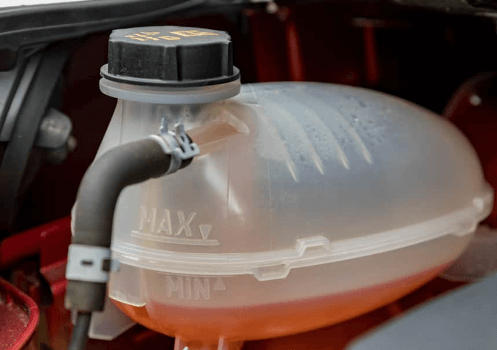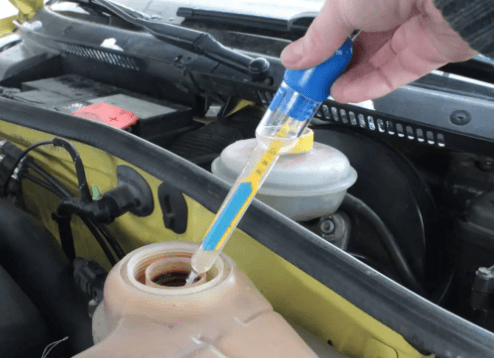Coolant typically takes only a few seconds to circulate through the engine block and reach the thermostat, which regulates its temperature. Once the thermostat opens, the coolant will flow into the radiator, where it will be cooled by air passing over the radiator fins.
Keeping your engine cool is essential for optimal performance and preventing damage. Coolant, also known as antifreeze, plays a crucial role in maintaining a stable engine temperature. But how long does it take for coolant to start working? In general, it takes only a few seconds for the coolant to circulate through the engine block and reach the thermostat.
Once the thermostat opens, the coolant flows into the radiator, where it is cooled by air passing over the radiator fins. Understanding how long it takes for coolant to work can help you determine if there may be an issue with your cooling system or if you need to add more coolant.
We will explore the time it takes for coolant to effectively regulate engine temperature and provide some insights on when it’s necessary to run the engine with or without the radiator cap off.
Understanding Coolant Circulation
In general, it takes only a few seconds for the coolant to circulate through the engine block and reach the thermostat, which regulates the temperature of the coolant. Once the thermostat opens, the coolant will begin to flow into the radiator, where it will be cooled by air passing over the radiator fins.
How Coolant Circulates Through The Engine Block And Radiator (in General, Within Seconds)
Coolant circulates through the engine block and radiator in a continuous loop, ensuring optimal engine temperature. Here is a step-by-step explanation of how the process works:
- The coolant is pumped from the radiator into the engine block through a series of hoses and passages.
- Once inside the engine block, the coolant absorbs heat from the engine components, helping to prevent overheating.
- The heated coolant then flows back into the radiator through another set of hoses.
- As the coolant passes through the radiator, air flowing over the radiator fins helps to cool it down.
- The cooled coolant then re-enters the engine block to repeat the cooling process.
The Role Of The Thermostat In Regulating Coolant Temperature
The thermostat plays a crucial role in regulating the temperature of the coolant and ensuring optimal engine performance. Here’s how it works:
- The thermostat is located between the engine block and the radiator and acts as a valve.
- When the engine is cold, the thermostat remains closed, preventing coolant from flowing into the radiator.
- As the engine heats up, the thermostat gradually opens, allowing coolant to flow into the radiator to be cooled.
- If the engine temperature drops, the thermostat will close again to conserve heat and raise the temperature.
- The thermostat continuously regulates the coolant flow to maintain the engine at the ideal operating temperature.
How The Radiator Cools The Coolant With Air Passing Over The Fins
The radiator is a key component in the cooling system and is responsible for dissipating heat from the coolant. Here’s how it cools the coolant:
- The radiator consists of a network of small tubes and rows of fins, which increase the surface area for heat exchange.
- As the hot coolant flows through the tubes, air passing over the fins helps to cool it down.
- The heat from the coolant is transferred to the fins, and the air carries it away, cooling the coolant in the process.
- This cooled coolant is then circulated back into the engine block to absorb more heat and continue the cooling cycle.
Factors Affecting Coolant Efficiency
to run the engine after adding radiator coolant or only when draining? The answer is yes, it is necessary to run the engine after adding coolant to the radiator. This helps to remove any trapped air bubbles from the system, ensuring proper circulation of the coolant throughout the engine.

When it comes to the question of how long it takes for coolant to start working, the answer depends on several factors. Firstly, if you have just added coolant to your car’s engine, it can start working immediately under ideal conditions. However, it is important to note that the effectiveness of the coolant may vary based on the quality and type of coolant used.
If you are using a premixed coolant or have mixed the coolant with water, it should start working almost instantly. The coolant will circulate through the engine block and reach the thermostat within a few seconds. Once the thermostat opens, the coolant will flow into the radiator, where it will be cooled by air passing over the radiator fins.
However, if you suspect any issues with your car’s cooling system or the coolant is not working as expected, it is recommended to consult a mechanic. They have the expertise to diagnose and fix any coolant-related problems in your car.
Now, let’s address the question of driving without coolant and how long you can do so. Driving without coolant is extremely risky and can cause serious damage to your car’s engine. Coolant is responsible for regulating the temperature of the engine and preventing it from overheating. Without coolant, the engine can quickly reach high temperatures, leading to engine failure and costly repairs.
If you find yourself in a situation where you are low on coolant or suspect a coolant leak, it is important to address the issue immediately. If you notice a warning light or your engine temperature gauge is indicating a high temperature, pull over safely and turn off the engine. Driving without coolant for even a short period of time can have severe consequences and should be avoided at all costs.
When it comes to working on the coolant system, it is recommended to wait until the engine has cooled down before attempting any maintenance or repairs. The waiting time for the engine to cool down can vary depending on several factors such as the outside temperature and how long the engine has been running. As a general guideline, it is advisable to wait at least 30 minutes to an hour after turning off the engine before working on the coolant system.
This waiting period allows the engine to cool down sufficiently, reducing the risk of burns or injuries when working on the coolant system. Additionally, it also helps to prevent any coolant from spraying out due to pressure build-up when opening the radiator cap.
In conclusion, the time it takes for coolant to work can vary depending on the circumstances. Under normal conditions, coolant can start working immediately after adding it to the engine. However, it is crucial to ensure the proper functioning of the coolant system and address any issues immediately to prevent engine damage.
Remember, driving without coolant is extremely dangerous and should be avoided at all costs. When working on the coolant system, it is important to wait for the engine to cool down to reduce the risk of injuries and coolant spraying.
Importance Of Proper Coolant Management
Proper coolant management is vital for the efficient functioning and longevity of your vehicle’s engine. The coolant, also known as antifreeze, plays a crucial role in regulating the temperature of the engine and preventing it from overheating.
It helps dissipate excess heat and maintains optimal operating conditions, allowing various engine components to work harmoniously. By managing your coolant properly, you can ensure smooth engine performance, prevent costly repairs, and extend the lifespan of your vehicle.
Is It Necessary To Run The Engine After Adding Radiator Coolant Or Only When Draining?
Yes, it is necessary to run the engine after adding radiator coolant. Running the engine helps to get any air bubbles out of the system and allows the coolant to circulate effectively. This process ensures that the coolant reaches all parts of the engine, including the radiator and engine block, providing efficient cooling and preventing overheating.
The Recommended Wait Time For The Radiator To Cool Down Before Working On It
It is recommended to wait for the radiator to cool down before working on it to avoid burns and injuries. The cooling time may vary depending on various factors, such as the engine’s operating temperature and ambient temperature. Generally, it is advisable to wait at least 30 minutes to an hour after turning off the engine before attempting any work on the radiator.
Consequences Of Driving Without Antifreeze In Your Car
Driving without antifreeze in your car can have severe consequences for your vehicle’s engine. Antifreeze not only helps regulate the engine’s temperature but also provides protection against freezing in colder climates or boiling in hotter conditions.
Without antifreeze, the engine can overheat, leading to potential damage to components such as the head gasket, cylinder head, or even the engine block. Additionally, driving without antifreeze can cause corrosion and rust within the cooling system, further compromising its efficiency and lifespan.
How Quickly Does Coolant Circulate Through The System?
Coolant circulates through the system within a matter of seconds after starting the engine. It takes only a few seconds for the coolant to reach the engine block and reach the thermostat, which regulates the temperature.
Once the thermostat opens, allowing coolant flow, it will begin to circulate through the radiator, where it gets cooled down by air passing over the radiator fins. This rapid circulation ensures timely cooling of the engine and helps maintain optimal operating conditions.
Effective Cooling Techniques
After driving your car, it’s essential to allow enough time for it to cool down completely before adding coolant. The cooling process typically takes around 30 minutes to an hour, depending on various factors such as the outside temperature, engine size, and driving conditions.
It is generally safe to drive your vehicle immediately after adding coolant. However, it is recommended to wait for a few minutes to allow the coolant to circulate through the cooling system and distribute evenly. This will ensure optimal performance and prevent any potential issues.
When bleeding a car cooling system by yourself, it is important to follow these steps:
- Start with a cold engine and ensure the car is parked on a level surface.
- Locate the radiator cap and coolant reservoir.
- Open the radiator cap slowly to release any built-up pressure.
- Add coolant to the radiator and reservoir as needed, ensuring the levels are within the recommended range.
- Turn on the engine and let it run for a few minutes to allow the coolant to circulate.
- Check the coolant level again and add more if necessary.
- Repeat the process until the coolant level remains stable and there are no air bubbles.
- Finally, secure the radiator cap tightly and ensure there are no leaks.
After adding coolant, it is best to wait for the engine to cool down before performing any further maintenance or checks. This ensures that the coolant has properly settled and reached its desired temperature for accurate readings. It is recommended to wait at least 15-30 minutes before handling the engine or checking the coolant level.
Credit: www.lifeasastrawberry.com
Frequently Asked Questions For How Long Does It Take For Coolant To Work
How Long Does It Take For An Engine To Cool Down After Adding Coolant?
After adding coolant, it takes only a few seconds for it to circulate through the engine block and reach the thermostat. Once the thermostat opens, the coolant flows into the radiator and is cooled by air passing over the radiator fins.
It is not necessary to let the engine cool down completely before checking the coolant level.
Should I Let My Car Run After Adding Coolant?
Yes, it is necessary to let your car run after adding coolant. This helps to remove any air bubbles from the system and ensure proper circulation. Running the engine also helps prevent damage caused by expanding gases.
How Fast Should Coolant Flow Through Radiator?
Coolant should flow through the radiator at a typical rate and temperature.
How Long Does It Take For Coolant To Start Working In My Car?
In general, it takes only a few seconds for the coolant to circulate through the engine block and reach the thermostat, which regulates the temperature of the coolant. Once the thermostat opens, the coolant will begin to flow into the radiator, where it will be cooled by air passing over the radiator fins.
So, you can expect the coolant to start working within a few seconds.
Conclusion
Once you add coolant to your car’s engine, it takes only a few seconds for it to circulate through the engine block and reach the thermostat. From there, it will flow into the radiator and be cooled by the air passing over the fins.
Under ideal conditions, coolant can work immediately. However, it is recommended to run the engine after adding coolant to get any air bubbles out of the system. Overall, it is important to wait for the engine to cool down before checking or adding coolant.


Leave a Reply